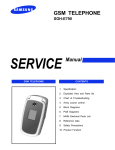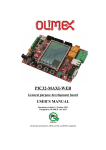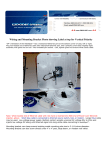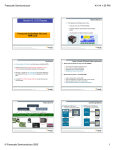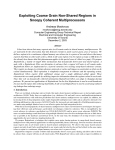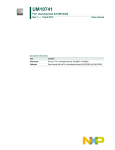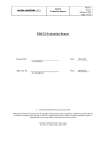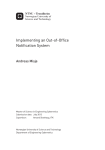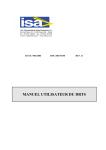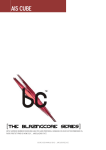Download SIM102 User Manual A1 ENUS
Transcript
SERIOUS INTEGRATED MODULE SIM102 USERS MANUAL SIM102Users Manual 2 IMPORTANT LEGAL NOTICE Yes, our attorneys made us put this in. But you really should read and understand this. Information herein is provided in connection with Serious Integrated, Inc. (“SERIOUS”) products. The products may be comprised of components designed and manufactured by SERIOUS as well as other vendors. This information may refer to a variety of specifications related to those non-SERIOUS components for informational purposes only, and the user is strongly urged to consult the original manufacturers’ data sheets and other documentation for authoritative specifications. No license, express or implied, by estoppel or otherwise, to any intellectual property rights is granted by this information. SERIOUS assumes no liability whatsoever, and SERIOUS disclaims any warranties whether express or implied, written, oral, statutory or otherwise relating to the information and it use, including any liability for warranties relating to fitness for a particular purpose, performance, quality, merchantability, or infringement of any patent, copyright or other intellectual property right.. The user is responsible for determining the suitability of SERIOUS products for the intended application and that applicable specifications are met. SERIOUS makes no representations or warranties with respect to the accuracy or completeness of the information and may make changes to the information, specifications and product descriptions at any time without notice. Designers should not rely on the absence or characteristics of any features or instructions marked “reserved” or “undefined.” SERIOUS reserves these for future definition and shall have no responsibility whatsoever for conflicts or incompatibilities arising from future changes to such features or instructions. SERIOUS products may contain design defects or errors known as errata which may cause the product to deviate from published specifications. Current characterized errata are available upon request. Use of SERIOUS products in automotive, military, aircraft, space, life saving or life sustaining applications or in any systems where failure or malfunction may result in personal injury, death or severe property or environmental damage is entirely at the buyer’s risk and the buyer agrees to defend, indemnify and hold harmless SERIOUS from any and all damages, claims, suits or expenses resulting from such use. TRADEMARKS AND COPYRIGHTS The “Serious” name and stylized Serious mark are trademarks of Serious Integrated, Inc. The information herein, unless otherwise indicated, is Copyright 2010 Serious Integrated, Inc. Third party brands and names are the property of their respective owners. © Serious Integrated, Inc. PRELIMINARY Document Revision A1 SIM102Users Manual 3 CONTENTS IMPORTANT LEGAL NOTICE................................................................................................................. 2 TRADEMARKS AND COPYRIGHTS ......................................................................................................... 2 Document Information and Applicable Products ..................................................................................... 5 Change History and Applicable Products ............................................................................................. 5 Document Conventions ....................................................................................................................... 5 Introduction ............................................................................................................................................ 6 Hardware............................................................................................................................................. 6 Software .............................................................................................................................................. 6 Usage Models ...................................................................................................................................... 6 Hardware Architectural Overview ............................................................................................................ 8 MCU and Touch Screen ....................................................................................................................... 8 On-Module Peripherals ........................................................................................................................ 8 On-Module Memory ............................................................................................................................ 9 Communications ................................................................................................................................. 9 Power .................................................................................................................................................. 9 Module Feature Detail ........................................................................................................................... 10 MCU .................................................................................................................................................. 10 Graphic LCD Display.......................................................................................................................... 10 Touch .................................................................................................................................................12 Select Switch, LEDs, and Reset# ..........................................................................................................12 Real Time Clock/Calendar (RTCC) with EEPROM and Serial SRAM ....................................................... 13 RTCC Battery Backup ...................................................................................................................... 13 RTCC Real time Clock Temperature Compensation .........................................................................14 Unique Serial Number.....................................................................................................................14 Serial FLASH ........................................................................................................................................14 Temperature Sensor ...........................................................................................................................14 © Serious Integrated, Inc. PRELIMINARY Document Revision A1 SIM102Users Manual 4 USB Port .............................................................................................................................................15 Power Supplies ...................................................................................................................................16 5V to 3.3V Main Power Regulator ....................................................................................................16 LCD Panel Backlight Power .............................................................................................................16 USB Power ......................................................................................................................................16 Clock/Calendar Battery Power......................................................................................................... 17 Time Keeping, Clock Circuits and Oscillators ...................................................................................... 17 Oscillators .......................................................................................................................................18 RTCC and Time Keeping .................................................................................................................18 CPU and Peripheral Clocks ..............................................................................................................19 RS232 Connector ................................................................................................................................19 Baseboard Connector ........................................................................................................................ 20 ICSP Debug Connector .......................................................................................................................21 Schematics ............................................................................................................................................ 23 © Serious Integrated, Inc. PRELIMINARY Document Revision A1 SIM102Users Manual 5 DOCUMENT INFORMATION AND APPLICABLE PRODUCTS CHANGE HISTORY AND APPLICABLE PRODUCTS The following table summarizes major changes to this document and the applicable versions of the product corresponding to this document: Document Version Date A0 12dec10 Applicable Hardware Versions 2.2 A1 31dec10 2.3 Major Changes Initial version for pre-production hardware Updated for production hardware v2.3 LED Backlight section revised: LED Backlight SHDN pin is pulled-down (not up) and tip on backlight PWM possibility added. Schematics updated for changes mentioned above. DOCUMENT CONVENTIONS This symbol indicates an advanced tip for hardware or software designers to extract interesting or unique value from the SIM102. WARNING: You can damage your board, damage attached systems, overheat or cause things to catch fire if you do not heed these warnings. © Serious Integrated, Inc. PRELIMINARY Document Revision A1 SIM102Users Manual 6 INTRODUCTION The Serious Integrated Module SIM102 is a complete intelligent graphic/touch front panel for use by Original Equipment Manufacturers (OEMs), custom design shops, and hobbyists to add a sophisticated and user-friendly user interface to their products. HARDWARE SIM102 hardware features include: 3.2″ QVGA 18-bit color 320×240 TFT Touch Display 80MHz 32-bit Microchip PIC32MX695 MCU with 512KB Flash, 128KB RAM 4MB (32Mbit) Serial FLASH for program, image, and data storage Battery Backed Real Time Clock/Calendar with 1Kbit EEPROM and 64 bytes parameter SRAM On-Module Temperature Sensor USB port (host, slave, and OTG modes supported) Baseboard connector: SPI, I2C, USB, Serial, and GPIO ports RS232 debug port Two bi-color LEDs and consumer-friendly “select” pushbutton Microchip standard debug port for PICKit3, ICD3, as well as RealICE with the RJ11 to ICSP Adapter Indoor/outdoor capable: full -40°C to +85°C functionality except touch screen -10°C to +60°C SOFTWARE The SIM 102 is supported by a growing array of both open source as well as Serious proprietary software allowing designers to gain confidence that their essential software can not only get done, but perform to the needed end result. It is very difficult to know, as a designer selecting the hardware for a graphic/touch interface, if the result after many months of software and graphic design will have acceptable performance. Will the system be responsive? Will it be visually attractive? Will the look-andfeel be consistent with the company’s brand image? Serious will continue to address this designers’ dilemma by adding video best-of-class GUI examples, fostering community demos and solutions, and through our proprietary software, tools, and consulting services. USAGE MODELS The SIM102 can be used as a stand-alone controller for a whole system – where all the intelligence and control is in the SIM102 and there are no external components -- or can act just as a front-panel touch/graphic human interface, a sort of “super-keyboard”, to an attached intelligent system. In reality, there are many of usage models in between these extremes. Normally, there is additional functionality in the system beyond the SIM102 from a hardware perspective, and so the SIM102 is connected via the Baseboard Connector to a host system. The Baseboard Connector is quite flexible, utilizing several industry-standard interfaces including I2C, SPI, USB, and high-speed-serial as well as general purpose programmable I/O (GPIO) lines. See the Baseboard Connector section for details. Often a designer has an existing product with a traditional button-and-segment-LCD user interface and is seeking to give the product an “extreme makeover” with a new front graphic/touch panel. The existing design may already be an intelligent system, such as a pool control system including motor controllers, © Serious Integrated, Inc. PRELIMINARY Document Revision A1 SIM102Users Manual 7 valve relays, sensors, and power supply circuits as well as its own microcontroller (MCU). All the user configuration and operation of the system is managed by the existing MCU and its software. Rather than completely redesigning the hardware and software of the existing OEM system, the old front panel can be replaced by a simple connection through the SIM102’s Baseboard Connector. The designer can then architect inter-board messages like “pump is on” which could be sent over a chosen serial port (say, I2C) in the Baseboard connector causing visual indicators to change on the display. A GUI on the SIM102 could change user preferences, for instance, sending back messages like “pump on days: MWF” which the baseboard could store in its configuration EEPROM. The possibilities are endless: the SIM102 module contains not only a powerful MCU but also a suite of hardware features that are commonly needed in many designs. The baseboard for a high-end thermostat, for example, could be a simple as a few relays and a battery. © Serious Integrated, Inc. PRELIMINARY Document Revision A1 SIM102Users Manual 8 HARDWARE ARCHITECTURAL OVERVIEW SIM102 Hardware Block Diagram MCU AND TOUCH SCREEN The heart of the SIM102 is the on-module MCU and graphic/touch LCD screen. The MCU on the SIM102 is an 80MHz 32-bit Microchip PIC32MX695 with 520KB FLASH memory and 128KB on-chip SRAM. This MCU is one of the most powerful microcontrollers in its class on the market, and is equipped with extensive analog and digital peripherals. Development and debugging of the PIC32 is inexpensive and easy via Microchip’s MPLAB IDE and associated hardware debug tools like the PICKit3. The touch screen on the SIM102 Rev A is a Truly TFT2N0369-E, a 3.2” 18-bit color TFT with integrated 4wire resistive touch layer. The resistive touch layer returns an analog voltage in two dimensions which can be read by the MCU’s analog-to-digital converters and translated with a simple algorithm into a pixel hit position. ON-MODULE PERIPHERALS The SIM102 contains numerous on-module peripherals – many common to a vast and diverse set OEM applications, including a battery-backed Real Time Clock/Calendar (RTCC), temperature sensor, USB, SPI, I2C, high speed and RS232 serial ports, EEPROM, bi-color LEDs and user “select” switch and much more. © Serious Integrated, Inc. PRELIMINARY Document Revision A1 SIM102Users Manual 9 ON-MODULE MEMORY The SIM102 module has a variety of memory for storage of program, data, images, parameters, etc: FLASH Memory: 520 Kbytes total FLASH memory within the PIC32 MCU 4 Mbytes (32 Mbits) serial FLASH memory attached via dedicated SPI EEPROM Memory 1Kbits EEPROM within the RTCC chip RAM Memory 64 Bytes battery backed serial RAM within the RTCC chip accessible via I2C 128 Kbytes RAM within the PIC32 MCU 168.75 KBytes of RAM within the on-glass SSD1289 LCD controller used for graphics frame buffer storage COMMUNICATIONS The SIM102 has numerous off-module communication ports: Baseboard Connector: Dedicated and independent SPI, I2C, high-speed serial ports, individually GPIO reclaimable USB 2.0 full speed OTG port (including host, slave, dual-role modes), shared with USB mini connector Two general purpose I/O (GPIO), two signals VBAT signal from the battery back-up System reset USB Mini Connector Shared with pins on the Baseboard Connector USB 2.0 full speed slave port RS232 Port Connector Standard RS232 port with hardware flow control signals Microchip ICSP Debug Connector For connection to Microchip development Compatible with PICKit3, ICD3, as well as RealICE with the RJ11 to ICSP Adapter POWER The SIM102 module should be powered with a +5V power supply via the USB port or the power pins on the Baseboard Connector. For development, it is common to power the module via the USB port attached to the PC via a powered USB hub. The Baseboard Connector also supports the VBAT pin, which provides battery power to the batterybacked real time clock/calendar (RTCC) chip The RTCC chip uses main system power when possible, and automatically switches to the battery input when main power is lost. WARNING: Either the VBAT pin should be powered from the baseboard or a 20mm coin cell can be inserted into the SIM102 but not both: this is not a switched input. © Serious Integrated, Inc. PRELIMINARY Document Revision A1 SIM102Users Manual 10 MODULE FEATURE DETAIL MCU The MCU on the SIM102 is an 80MHz 32-bit Microchip PIC32MX695. The PIC32 is one of the highest performing microcontrollers in its class, and makes an excellent engine for the SIM102. Features include: MCU Core & Memory 80MHz, 1.56 DMIPS/MHz, 32-bit MIPS M4K® Harvard architecture core with 5 stage pipeline MIPS16e mode for up to 40%smaller code size 512 KBytes Flash plus 12K boot Flash 128 KBytes 0 wait state RAM Single cycle multiply and hardware divide unit 64 (yes, 64!) 32-bit registers Fast context switching and interrupt response times Key Peripherals USB 2.0 port with host/device/dual-role/OTG modes and integrated PHY and dedicated DMA channels 8 channel general hardware DMA controller Fast and relatively accurate 16 channel 10-bit ADC Hardware RTCC (real-time clock and calendar with alarms) Watchdog timer Numerous SPI, I2C, and high-speed-capable serial ports Microchip provides extensive documentation of the PIC32 as well as example software: consult their website. In addition, there are many community resources for PIC32 MCU developers, including the Microchip forums as well as www.myPIC32.com. GRAPHIC LCD DISPLAY The touch screen on the SIM102 Rev A is a Truly TFT2N0369-E, a 3.2” 320x240 pixel 18-bit color TFT with integrated 4-wire resistive touch layer. The display has an integrated Solomon Systech SSD1289 controller with integrated RAM frame buffer and landscape/portrait rotation modes. Features include: Parameter Value LCD type Viewing Area TFT TRANSMISSIVE 3.189” (81mm) diagonal 64.8mm x 48.60mm 320 x 240 16-bit RGB565 18-bit RGB666 172,800 Bytes 5 LED Pixel Dimensions/Depth On Board Frame Buffer Backlight Type Power Consumption Backlight (typical) Base LCD Display (max) Operating Temperature LCD SSD1289 © Serious Integrated, Inc. 233mW 84.24mW -10°C to +60°C -45°C to +85°C PRELIMINARY Document Revision A1 SIM102Users Manual 11 Of particular note are the operating temperature specifications. While the Truly panel is only rated -10°C to +60°C, the SSD1289 itself has a much wider operating range. The user must examine these specifications carefully and contact Truly as appropriate to understand any potential for, and ramifications of, using the module outside the specified module-level temperature range. Even though the touch screen may not be functionally outside -10°C to +60°C, the rest of the SIM102 is rated -40°C to +85°C so properly designed software can allow the system to continue to function – albeit without the ability for user interaction. This might be useful, for instance, in an outdoor landscape lighting controller where the lighting system could still be automatically operated by the base functionality of the SIM102 in winter, even if it were too cold to modify the settings as the display was inoperable below 10°C. The LCD touch panel is connected to the PIC32’s Parallel Master Port (PMP) in 16-bit transfer mode: Signal Signal J4 MCU MCU Name Description Pin Pin Pin Name P32_LCD_CS LCD chip select 39 70 RD10/PMCS2 P32_LCD_RD LCD read strobe 33 82 RD5/PMRD P32_LCD_WR LCD write strobe 34 81 RD4/PMWR P32_LCD_DC LCD data/command strobe 35 72 RD0 P32_LCD_D0 LCD data bit 0 32 93 RE0/PMD0 P32_LCD_D1 LCD data bit 1 31 94 RE1/PMD1 P32_LCD_D2 LCD data bit 2 30 98 RE2/PMD2 P32_LCD_D3 LCD data bit 3 29 99 RE3/PMD3 P32_LCD_D4 LCD data bit 4 28 100 RE4/PMD4 P32_LCD_D5 LCD data bit 5 27 3 RE5/PMD5 P32_LCD_D6 LCD data bit 6 26 4 RE6/PMD6 P32_LCD_D7 LCD data bit 7 25 5 RE7/PMD7 P32_LCD_D8 LCD data bit 8 22 90 RG0/PMD8 P32_LCD_D9 LCD data bit 9 21 89 RG1/PMD9 P32_LCD_D10 LCD data bit 10 20 88 RF1/PMD10 P32_LCD_D11 LCD data bit 11 19 87 RF0/PMD11 P32_LCD_D12 LCD data bit 12 18 79 RD12/PMD12 P32_LCD_D13 LCD data bit 13 17 80 RD13/PMD13 P32_LCD_D14 LCD data bit 14 16 83 RD6/PMD14 P32_LCD_D15 LCD data bit 15 15 84 RD7PMD15 P32_LCD_RESET LCD reset 10 69 RD9 PS[3:0] LCD configuration bits 8,5,6,7 LED+ LED backlight anode 1 - - LED- LED backlight cathode 2 - - BACKLIGHT_EN LCD backlight enable - 78 RD3/OC4 The highest bandwidth pathway in the system exists between the MCU and the LCD. The LCD contains an on-glass 320x240 pixel RAM frame buffer and the MCU writes and reads the frame buffer through a high speed 16-bit Parallel Master Port (PMP). This interface is DMA capable for transmitting large amounts of data efficiently to the panel. © Serious Integrated, Inc. PRELIMINARY Document Revision A1 SIM102Users Manual 12 A pixel-write, for example, involves the MCU writing a pixel-address to the TFT followed by a color. For a whole-frame-fill (for example, a picture being displayed), the amount of data moved can be significant: 320 * 240 pixels * 18 bits-per-pixel (2 16-bit-word-writes) is nearly 300Kbytes of data to move in a very short timeframe. Through the use of the MCU’s DMA controller this amount of data can be moved in a fraction of a second to the display. See the Truly documentation and specifications for more details on the LCD panel, as well as the Solomon documentation for programming information. TOUCH The SIM102 LCD panel has an integrated 4-wire touch layer connected to the Analog-to-Digital Converter of the microcontroller: J2 MCU MCU Signal Description Pin Pin Name TOUCH0 X+ 1 34 AN10/RB10 TOUCH1 Y- 2 35 AN11/RB11 TOUCH2 X- 3 41 AN12/RB12 TOUCH3 Y+ 4 42 AN13/RB13 The resistive touch layer returns a proportionate voltage in two dimensions which are fed into the MCU’s analog-to-digital converters and can be translated with a simple algorithm into a pixel hit position. Resistive type touch layers have the significant advantage of being robust and usable with a stylus, finger, or any blunt object. Unlike typical capacitive touch screens, resistive touch screens do not require the bare finger and can be used with gloves on – important for certain medical, industrial, and automotive applications. One challenge with resistive touch layers is power: applying power through the resistive layer is required to sense the change in resistance created when touched. Doing a “wakeup” sense therefore requires continuous or (say) 5x per second application of power to the layer, which can cause measurable power consumption from batteries just to detect a wakeup event – defeating the whole purpose of going to sleep in the hardware to save power. One commonly employed option for the system designer in this scenario is to use an actual wakeup/select switch that is wired to a processor interrupt pin so that the resistive layer can be dormant during sleep. The “select” button on the SIM102 can be easily used for this purpose. SELECT SWITCH, LEDS, AND RESET# The SIM102 has a single consumer-friendly “select” switch below the LCD panel. The switch is connected to an MCU input that is both a general purpose input and also an interrupt input that can wake the MCU from various sleep modes. Two bi-color red-green LEDs are placed at the lower left and right corners of the module respectively. A bi-color LED is actually two independent LEDs in one package: the LEDs on the SIM102 have red and green LEDs that when both on have an amber hue. The circuit board accommodates the addition of an off-the-shelf press-fit plastic light pipe (Premier/Farnel p/n 71C3772, Mentor p/n 1275.1001) to deliver the LEDs’ light out through an enclosure. © Serious Integrated, Inc. PRELIMINARY Document Revision A1 SIM102Users Manual Switch Input (active low) MCU Pin 20 MCU Name RE9/INT2 LED0 Left Red 25 RB3 LED1 Left Green 24 RB2 LED2 Right Red 23 RB1 LED3 Right Green 22 RB0 MCLR# Reset (active low) 13 MCLR Signal Description S2# 13 Many applications, like an irrigation controller for instance, require a clock/calendar. REAL TIME CLOCK/CALENDAR (RTCC) WITH EEPROM AND SERIAL SRAM Many applications, like an irrigation controller for instance, require a clock/calendar. The SIM102 contains a unique and useful component: the Microchip MCP7941x series of Real Time Clock/Calendar (RTCC) chips. The core function of this chip is to ensure a clock/calendar for the module (and potentially the whole system). The RTCC chip is more than just a battery backed up clock, however. It also has 1 Kbits (128 Bytes) of EEPROM as well as 64 bytes of battery back serial SRAM and a built-in unique ID. The RTCC is connected to the MCU via the I2C2 port of the MCU, a shared connection with the I2C temperature sensor. The MCP7941x uses multiple I2C address spaces for SRAM, EEPROM and register access. The RTCC chip in the SIM102 has an attached 32.768 KHz crystal, and as such “owns” the system 32.768 KHz clock. The logic-level clock output signal from the RTCC’s MFP pin is connected into the MCU’s SOSCO clock input so that the MCU has access to this clock without a redundant crystal. The RTCC should be programmed to generate the 32.768 KHz in a divide-by-one configuration. RTCC Name SDA MCU Name RA3/SDA2 Signal Description P32_SDA I2C Serial Data Pin 5 P32_SCL I2C Serial Clock 6 SCL 58 RA2/SCL2 CLK_32KHZ Generated 32.768 KHz clock to MCU 7 MFP 74 SOSCO Pin 59 See the Microchip documentation and specifications for more details on the RTCC chip. RTCC BATTERY BACKUP WARNING: Either the VBAT pin should be powered from the baseboard or a 20mm coin cell can be inserted into the SIM102 but not both: this is not a switched input. The RTCC chip has two power inputs: a “main” power input connected to the main module power along with a battery input pin called VBAT. The RTCC is normally powered from the main module power, but when main power fails it automatically switches to battery power. Battery power can be supplied by inserted a standard CR2032 type 20mm coin cell into the module or by supplying external © Serious Integrated, Inc. PRELIMINARY Document Revision A1 SIM102Users Manual 14 VBAT power on the Baseboard Connector. With a typical battery, the clock/calendar could run for up to several years without replacement. Consult the Microchip specifications for battery life expectations. RTCC REAL TIME CLOCK TEMPERATURE COMPENSATION The MCP7941x supports calibration for extended accuracy. When combined with the SIM102’s onmodule temperature sensor, software could be developed to calibrate the RTCC beyond its basic built-in un-calibrated accuracy, though the out-of-the-box precision is usually sufficient for most applications. In addition, the RTCC supports an alarm feature which allows software to set an alarm, put the MCU and associated circuitry in deep sleep, and have the alarm wake the system up at a future time. UNIQUE SERIAL NUMBER The built-in ID in the RTCC can be used as an Ethernet MAC address, but is also used as the serial number for the module. If the printed serial number on the module circuit board is ever rendered unreadable, the built-in ID from the on-module RTCC contains the actual serial number of the module and it can be fetched by writing a small amount of software. SERIAL FLASH The on-module SST25VF032B serial FLASH is a 32 megabit (4 megabyte) device with 1024 4KByte erasable blocks. It is connected via a dedicated SPI port to the MCU to optimize data transfers, especially when images need to be retrieved on-demand and delivered directly to the display. The serial FLASH is directly connected to the SPI3 port of the MCU and is not shared by other peripherals. At 25MHz, a full screen 16-bit-per-pixel image could theoretically be streamed via DMA from the FLASH to the display in less than 50 milliseconds. SPI data input FLASH Pin 2 FLASH Name SDO MCU Pin 52 MCU Name RF2/SDA1A SPI data output 5 SDI 53 RF8/SCL1A P32_SCK SPI clock 6 SCK 48 RD15/SCK1A P32_SSN SPI slave select 1 CS 47 RD14/SS1A# Signal Name Description P32_SDI P32_SDO See the Microchip documentation and specifications for more details on the serial FLASH chip. TEMPERATURE SENSOR The SIM102 contains a relatively accurate MCP9801 Temperature for this device are: Parameter Accuracy (°C) Typical @ 25°C Worst Case @ -10°C to +85°C Supply Current (µA) Typical © Serious Integrated, Inc. PRELIMINARY Sensor. The high level specifications Value ±0.5°C ±1.0°C 220 Document Revision A1 SIM102Users Manual Max Shutdown Max 15 400 1 The sensor supports 9-12 bit resolution, depending on how long you want to wait for a reading, but even 12-bit temperature read operations can typically be done 4 times per second. Software can be written to use the temperature to help temperature-compensate the RTCC for extreme clock accuracy. See Microchip’s application note AN1001 for an example of this compensation technique. The temperature sensor is an I2C device, and shares an I2C connection with the RTCC chip. The temperature sensor A[2:0] address bits are hard coded on the module to 0x0 which results in an I2C address A[6:0] of 0x48 and communicates on port I2C2 of the MCU. TS TS MCU MCU Signal Name Description Pin Name Pin Name P32_SDA I2C Serial Data 1 SDA 59 RA3/SDA2 P32_SCL I2C Serial Clock 2 SCL 58 RA2/SCL2 TEMP_ALERT Temperature Alert Signal 3 ALERT 18 RE8/INT1 The sensor’s TEMP_ALERT signal is connected to MCU pin RE8 which also doubles as the INT1 interrupt source, and the TEMP_ALERT signal can be programmed on the sensor to signal the MCU when a programmed temperature limit has been exceeded. See the Microchip documentation and specifications for more details on the temperature sensor chip. USB PORT The PIC32 MCU has an on-chip USB 2.0 Full Speed (12Mbit/s) port. It supports host, device, dual-role, and On-the-Go (OTG) modes. On the SIM102, the D+/D- device-mode pins are exposed on the standard mini-USB connector. This connector can also provide power into the whole module, assuming the USB source has sufficient power capabilities. Some notebook/netbook USB ports cannot provide sufficient power, especially when the display backlight is turned on, and it is recommended that when powering from the USB port that a powered hub is used. Note that the mini-USB connector does not provide power output, even when the port is placed in host mode. Host modes (including supplying power out to a USB device like a thumb drive for instance) are only accommodated through a user-designed baseboard circuit. Power is automatically switched between the USB port and the Baseboard Connector +5VDC pins: whichever voltage is higher is used by the board, and power applied to the Baseboard Connector +5VDC pins will not flow to the mini-USB pin. WARNING: The VUSB pin on the Baseboard Connector is directly connected to the V+ pin on the mini-USB connector. DO NOT connect both to a power supply simultaneously. Microchip provides extensive documentation of the PIC32 as well as example software: consult their website. In addition, the Microchip software libraries include USB host, device, dual-role, and OTG example source code. © Serious Integrated, Inc. PRELIMINARY Document Revision A1 SIM102Users Manual 16 POWER SUPPLIES 5V TO 3.3V MAIN POWER REGULATOR The SIM102’s primary internal voltage is 3.3V ±5%, delivered by the TC1262-3.3 low dropout (LDO) regulator. The input to that regulator can be power from either on the VUSB pin Baseboard Connector or the V+ pin on the mini-USB port or the +5V pins on the Baseboard Connector. On-module circuitry allows USB power and the +5V pins on the Baseboard connector to both be connected without contention: the higher voltage of the two being automatically used. For example, if the baseboard has a complete power supply supplying power to the SIM102 and a user plugs a laptop into the module via the mini-USB port, both the baseboard and the laptop are delivering power to the module. Whichever source’s voltage is higher will be used by the module: a simple pair of diodes prevents the two sources from being connected together. WARNING: The VUSB pin on the Baseboard Connector is directly connected to the V+ pin on the mini-USB connector. DO NOT connect both to a power supply simultaneously. LCD PANEL BACKLIGHT POWER The other power supply circuit on board drives the LED backlighting on the LCD panel. The LCD panel backlight requires approximately 15.5 volts @ 15mA = 233mW of power: the single largest user of power in the system. The on-module MCP1650 backlight controller chip boosts the input +5V power directly to the 15.5V required by the LCD panel; there is no need for an additional power supply input – all module power is derived from the +5V input (whether supplied via the USB or Baseboard Connector). In battery powered systems, software should carefully manage the backlight to be powered on as infrequently and for as short a time as possible. The backlight is turned on and off simply by toggling MCU port bit RD3/OC4. This is an active high signal, so setting the port to “1” turns the backlight on. The port bit on the MCU cold-resets to tri-state, and an external pull-down resistor ensures the backlight is off during power up and stays off until the software purposely turns it on. RD3/OC4 is usable as a pulse-width-modulated output (PWM). The Microchip MCP1650 Multiple White LED Demo Board User's Guide section 2.3.3 discusses the ability of modulating the MCP1650’s SHDN pin to vary LED intensity. USB POWER As mentioned above, the main 3.3V LDO regulator takes power from either the USB input or the +5V pins on the Baseboard Connector. Therefore, the module can be powered from the mini-USB jack from a powered USB source (like a powered USB hub, or a PC USB port that has sufficient power) or from a baseboard with its own power circuit. © Serious Integrated, Inc. PRELIMINARY Document Revision A1 SIM102Users Manual 17 Note that the SIM102 does not contain the power supply or connector for a USB host port. For instance, if you want to connect a thumb drive into the SIM102, the thumb drive needs the correct connector to plug into as well as to be supplied +5V to operate. All the signals needed to drive a USB host port are available on the Baseboard Connector, and a simple power supply can be constructed on the baseboard with the correct connector to enable this. An upcoming Serious application note will elaborate: check mySerious.com or contact Serious technical support on the mySerious.com site for more information. CLOCK/CALENDAR BATTERY POWER The SIM102 has a 20mm coin cell holder designed to accommodate a common CR2032-type 3V battery. This is not designed to be a rechargeable battery, nor does any circuit on the SIM102 supply power so as to charge this battery. The only purpose and connection of this coin cell is to provide backup power (called “VBAT“) to the MCP794xx RTCC chip to keep the clock/calendar running in the event that the main 5V power supply is removed. Consult the Microchip data sheet for exact specifications, but this battery can potentially keep the RTCC clock keeping time for several years without replacement. The RTCC chip automatically switches to use the coin cell power only when main power is not available, so in a system that normally has main power applied, the coin cell is used infrequently. However, in systems where the main power is supplied by a larger (say) rechargeable battery pack that commonly runs out after a few hours of use (like in a hand held portable device), the coin cell and RTCC chip could provide an excellent supplementary facility for maintaining information. See the Clock/Calendar section for more information. Note that the Baseboard Connector also has the VBAT pin on it. This pin is directly connected to the +ve side of the coin cell holder: WARNING: Either the VBAT pin should be powered from the baseboard or a 20mm coin cell can be inserted into the SIM102 but not both: this is not a switched input. There are two ways of using the VBAT pin on the Baseboard Connector: as an input or an output of backup power. As an input, the system designer can ignore the coin cell holder on the SIM102 (and never populate it) and drive the VBAT pin on the Baseboard Connector from a different coin cell or backup power source. As an output, the system design can populate the coin cell holder and use the VBAT pin on the Baseboard Connector to drive some other device on the baseboard that needs a 3V battery backup supply. Of course, this power adds to the power needed by the RTCC chip and will likely reduce the lifetime of the coin cell. TIME KEEPING, CLOCK CIRCUITS AND OSCILLATORS This discussion can be very confusing without some well-defined terminology: Clock: a square-wave logic-level periodic signal – NOT a clock as in a timekeeping clock of time/date/minutes/hours, etc. Oscillator: a crystal or resonating oscillator circuit that creates a fixed-frequency sine wave used in a specific circuit to create a clock signal © Serious Integrated, Inc. PRELIMINARY Document Revision A1 SIM102Users Manual RTCC: 18 a real time clock/calendar which keeps track of the correct time/date as set by the end user or some other means. There are many producers and consumers of stable clock signals (or “clocks”) on the SIM102. OSCILLATORS All clocks – including, for instance, the 80MHz CPU core clock, the 12MHz USB clock, and a 9,600baud serial port clock – can be traced back to an originating oscillator source somewhere. There are 5 oscillators in the SIM102: 1) The relatively accurate 32.768 KHz crystal oscillator attached to the RTCC chip. This oscillator is the source of all time and date keeping in the system. 2) The relatively accurate 8MHz crystal oscillator attached to the MCU, which is multiplied and divided in a variety of ways inside the MCU to generate the 80MHz the MCU runs at as well as all the different peripheral clocks 3) The internal 8MHz ±2%oscillator inside the PIC32 MCU, which can be used in lieu of the external 8MHz crystal oscillator. 4) The internal 750KHz oscillator inside the backlight controller chip used to boost the 5V to 15.5V needed by the LCD’s LED backlight circuit 5) The internal pixel oscillator/clock inside the LCD module that delivers pixels to the glass at a fixed rate These last two oscillators are mentioned for completeness only; there oscillators in the module are not normally accessible or used outside their intended function. The difference between the internal and external 8MHz oscillators on the PIC32 is worth some discussion. The external crystal is rated for operation -40°C to +85°C, the same range as the PIC32. Its accuracy is far better than the internal 8MHz ±2%(non-crystal) free-running oscillator. USB standards require you to use the external crystal oscillator as ±2%is not strict enough to meet USB requirements. There is no obvious reason on the SIM102 to use the internal free-running oscillator. RTCC AND TIME KEEPING Time keeping (i.e. year/month/day/hour/etc.) can be done in two places in the SIM102. The RTCC chip provides the capability of a battery-backed RTCC at extremely low power. As mentioned, the 32.768 KHz oscillator is attached to the RTCC chip. It has the ability to drive a clean 32.768 clock output which is connected to the PIC32’s internal RTCC circuit. These two RTCC capabilities are nearly identical from a software perspective. The difference: the external RTCC is battery-backed, whereas every time the main power is lost the time/date within the PIC32’s RTCC is lost. The most common way of using these dual RTCC capabilities is to, on cold boot, have software fetch the external battery-backed RTCC and set the PIC32’s internal RTCC based on that value. Then software in the PIC32 can rely on the internal RTCC during normal operation. If the user (or other capability) “sets” the clock, the software can write both the internal and external RTCC. © Serious Integrated, Inc. PRELIMINARY Document Revision A1 SIM102Users Manual 19 Note that the RTCC chip must be configured (via software and registers) to deliver the 32.768 KHz clock output to the PIC32 properly, and the PIC32 also must be configured to use that clock input correctly to drive its internal RTCC. Like all timekeeping devices, the RTCC will drift over time. Few timepieces are perfectly accurate! The drift and resulting inaccuracy are determined by the accuracy of the 32.768 KHz oscillator. Temperature variance is the most common culprit: crystals have slight variation in frequency over temperature. As mentioned in the RTCC section, software can be written to use the temperature sensor and the characteristics of the crystal to partially compensate for this effect resulting in a more accurate timekeeping capability. CPU AND PERIPHERAL CLOCKS The SIM102 uses the external 8MHz crystal oscillator attached to the PIC32’s input clock circuit as the primary source for all non-timekeeping clocks in the system. The PIC32 MCU, like all modern MCUs, has a sophisticated internal clock management circuitry which takes a few originating clock frequencies and out of those few inputs delivers a plethora of derivative clocks – some higher frequency, some lower. For instance, the PIC32 MCU can take a single 8MHz input clock and create derivative clocks like the core 80MHz MCU CPU clock as well as the clocks needed for various serial ports, like the (typically) 25MHz SPI port to the serial FLASH, a 9600 baud serial port clock, and the 12MHz clock on the USB port. The complexity and capabilities of the PIC32 MCU clock system are beyond the scope of this guide: consult the Microchip documentation for a complete description. RS232 CONNECTOR The venerable RS232 port, despite rumors of its demise, is still alive and well. While the Baseboard Connector has a high speed serial port capability at 3.3V levels, the RS232 connector delivers a full voltage RS232 port. Transmit and Receive signals (Tx, Rx) are complemented by hardware handshaking capability (RTS, CTS). The use of the hardware handshaking is at the discretion of the software that configures the PIC32’s serial port. The MCU utilizes the UART port 3 for the RS323 port. The header connector is identical to that still found on modern PC motherboards: a standard 10 pin (2x5) 0.1” header (commonly called an “IDC-10” header) that assumes it is the “terminal” (vs. “modem” or “peripheral”) in the RS232 relationship. J3 conforms to the new Intel/AT/Everex standard: IDC-10 DB9 RS232 RS232 MCU SIM102 MCU Header Male Signal Signal Pin Signal Pin Pin Pin Name Description Name 1 1 DCD Data Carrier Detect 2 2 RXD Receive Data P32_UART_RX 49 RF4/U3ARX 3 3 TXD Transmit Data P32_UART_TX 50 RF5/U3ATX 4 4 DTR Data Terminal Ready 5 5 GND Electrical Ground GND 6 6 DSR Data Set Ready 7 7 RTS Request to Send P32_UART_RTS 39 RF12/U3ARTS# 8 8 CTS Clear to Send P32_UART_CTS 40 RF13/U3ACTS# 9 9 RI Ring Indicator 10/key © Serious Integrated, Inc. PRELIMINARY Document Revision A1 SIM102Users Manual 20 The SIM102 utilizes this header connector vs. a traditional DB9 primarily because many designs will want that serial port to be a board-to-board connector, with the other end of the RS232 port on the baseboard. A DB9 cannot accommodate this usage model. Also, some systems would prefer a ribbon/header cable for the RS232 between boards. A DB9 cable is more expensive and significantly bulkier than a ribbon/header connector, and could get in the way of some mechanical system designs. Lastly, since many designs will not need the RS232 port and a 0.1” header is cheaper than a DB9, module prices are kept lower. If a DB9 without a cable is essential, either male or female, terminal or modem, the baseboard can accept the RS232 port’s header as a board-to-board connector and route the signals appropriately to a baseboard DB9 connector. An off-the-shelf “new Intel”/AT/Everex IDC-10 to DB9 male cable is inexpensive and easily found: a local Fry’s Electronics had 10 in stock at less than $4. Online sources include here, here and here. There are two different IDC-10 pin out formats: make sure you get the (more common) new Intel/AT/Everex 1-1, 2-2, 3-3… format, not the old Intel/DTK format. There has been significant confusion and debate on this difference in formats on the web, especially since Intel switched in the mid-2000’s. This simple cable allows direct connection to traditional RS232 peripherals like serial printers. However because this standard cable delivers an RS232 “terminal” experience via a DB9 male if connected to another “terminal” like a PC serial port or USB-to-Serial-cable, there needs to be a null modem adapter as well as a gender adapter (female-to-female) in between. One of the most common DB9 cables is a DB9-female-to-DB9-female-null-modem-cable; online sources include here, here and here. Alternatively, since most of the IDC-10 cables have a soldered DB9 male, it is possible to replace it with a little bit of soldering to a rewired DB9 female (crossing RX/TX, CTS/RTS, etc) and creating a complete all-in-one null modem cable. Note that the RS232 header is exactly in-line with the Baseboard Connector, with a 0.2” gap in between. This allows for a single long female header connector on the baseboard to accept both the Baseboard Connector as well as the RS232 port. Alternatively, the 0.2” gap allows for separate ribbon cable header connectors to be used without mechanical conflict. BASEBOARD CONNECTOR Much has been discussed already about the Baseboard Connector. In many systems, there will be extensive circuitry on some other board (called here the “baseboard”). The Baseboard Connector is the primary vehicle for making the SIM102 connected to another system, whether used as a board-to-board connector or with a ribbon/header cable. The Baseboard Connector is quite flexible. It can support the I2C, SPI, high speed serial, USB (OTG, Host, Device, and dual-role) as well as GPIO, battery backup power, system reset, and more. A careful examination of the PIC32 documentation yields the ability to reconfigure many of these pins to other modes, including GPIO. The 4 pin SPI port, for instance, can be reconfigured as 2 I2C ports (for 3 total on the connector) or 1 I2C + 1 Serial (yielding 2 I2C and 2 Serial on the connector). © Serious Integrated, Inc. PRELIMINARY Document Revision A1 SIM102Users Manual Signal Name GND 21 Module Ground J6 Pin 1 MCU Pin - MCU Name - GND Module Ground 2 - HOST_SSN/RX Host SPI 2A Slave Select or UART 2B Receive Data RX or UART 2A Clear to Send CTS# 3 14 VBAT VBAT battery backup power to RTCC if coin cell not inserted VBAT battery backup power from coin cell if inserted SPI: SS2A# UART:U2BRX UART:U2ACTS# RG9/CN11 4 - HOST_SDI/SDA Host SPI 2A Data In or I2C 2A Serial Data or UART 2A Receive Data RX 5 11 HOST_SDO/SCL Host SPI 2A Data Output or I2C 2A Serial Clock or UART 2A Transmit Data TX 6 12 USBID USB ID 7 51 HOST_SCK/TX Host SPI 2A Clock or UART 2B Transmit Data TX or UART 2A Ready To Send RTS# 8 10 D+ USB data positive signal 9 57 SPI:SDI2A I2C:SDA2A UART:U2ARX RG7/CN9 SPI:SDO2A I2C:SCL2A UART:U2ATX RG8/CN10 RF3/USBID SPI:SCK2A UART:U2BTX UART:U2ARTS# RG6/CN8 D+/RG2 D- 10 56 D-/RG3 11 66 SCL1/INT3/RA14 12 67 SDA1/INT4/RA15 +5V_USB USB data negative signal I2C 1 Clock or Host programmable General Purpose I/O I2C 1 Data or Host programmable General Purpose I/O USB +5V signal 13 54 VBUS P32_MCLR MCU reset signal, active low 14 13 MCLR HOST_VDD +3.3V from Host 15 - - HOST_VDD +3.3V from Host 16 - - Description HOST_GPIO1 HOST_GPIO2 - ICSP DEBUG CONNECTOR The Microchip standard ICSP debug connector allows simple connection to various Microchip debuggers and programmers, including the very inexpensive Microchip PICKit3, flexible and powerful ICD3, as well as the full featured RealICE when used with the RJ11 to ICSP Adapter. Signal J1 MCU MCU Description Name Pin Pin Name P32_MCLR Master Clear (Reset) 1 13 MCLR# P32_VDD © Serious Integrated, Inc. +3.3V of the MCU/system 2 PRELIMINARY - - Document Revision A1 SIM102Users Manual 22 GND Ground of the MCU/system 3 - - P32_PGD MCU Program Data 4 27 PGED2/RB7 P32_PGC MCU Program Control 5 26 PGEC2/RB6 This connector is purposely at a right angle to allow easy access to the various programmer/debuggers. For prototyping you could replace (at your own risk!) this right angle with a straight connector and it would conform to the in-line board-to-board mechanical philosophy of the RS232 port and Baseboard Connector, allowing you to do a board-to-board arrangement and (optionally) putting an RJ11 adapter on the baseboard for simple connectivity to the RealICE system. © Serious Integrated, Inc. PRELIMINARY Document Revision A1 SIM102Users Manual 23 SCHEMATICS © Serious Integrated, Inc. PRELIMINARY Document Revision A1 SIM102Users Manual © Serious Integrated, Inc. PRELIMINARY 24 Document Revision A1 SIM102Users Manual © Serious Integrated, Inc. PRELIMINARY 25 Document Revision A1

























